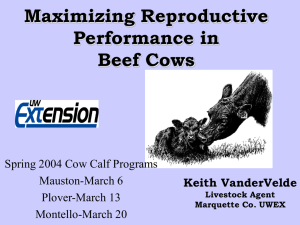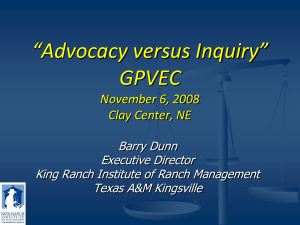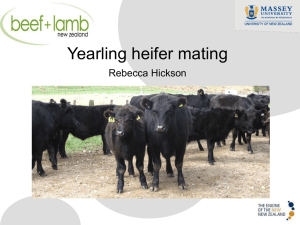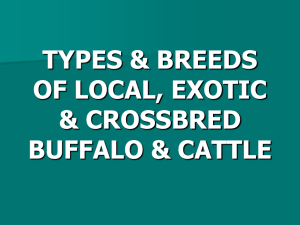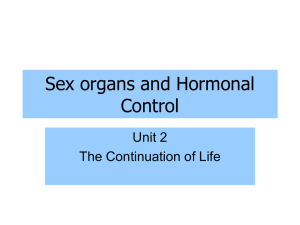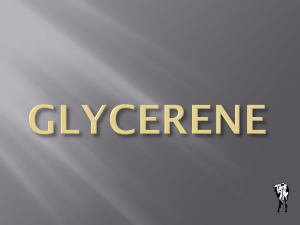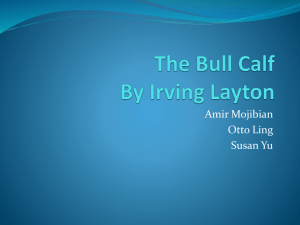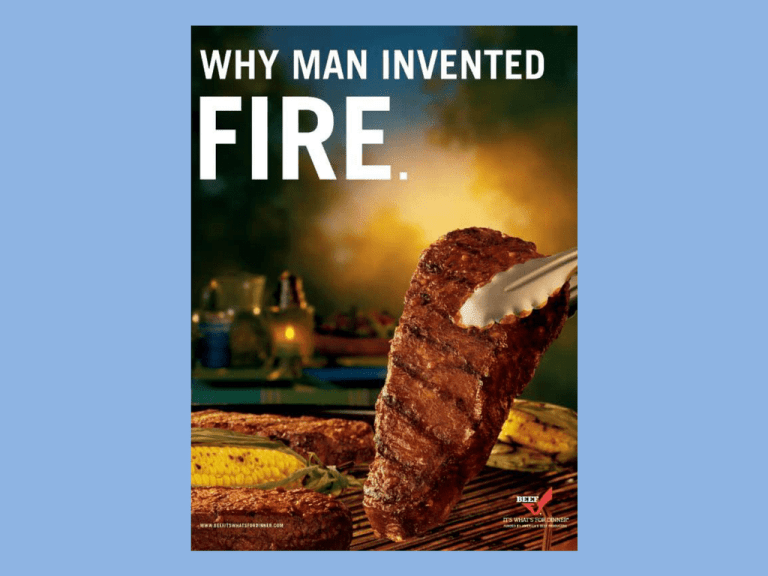
REPRODUCTION
•
•
•
•
•
•
•
Reproduction is most important trait
Bull - represents > 50% of the herd
No. of cows per bull ???
percent calf crop & conception rate
Ave. age of herd- Generation Interval
A. I. vs E. T. vs natural
Body Condition Scores (1-9)
Reproduction of Cattle
• functions of the cow
– produce eggs
– develop calf fetus
– give birth
– produce milk
• functions of the bull
– produce sperm, semen, and testosterone
Breeding and selection
• Breeding habits - 8-12 months of age
(Puberty)
• Age vs. size to breed 13-15 mos. or at least 65
% of mature weight (breed dependent)
• Estrus / 13-20 hours
• Estrous Cycle / 19-21 day intervals
• Occurrence / 6-8 weeks after parturition
Breeding and selection
• signs of estrus
– nervousness, attempts to mount others, swelling
of vulva, frequent urination, mucous discharge
• breed the last 10 hours of standing heat or the
first 10 hours after standing heat
• Twelve hours after observed in standing heat
or 16-20 hours after initial heat
MALE ANATOMY
• Testicles- primary sex organ
– produces sperm cells (spermatogenesis)
– Seminiferous tubules- within the testicle
• place where sperm cells are formed
– Interstitial or Leydig cells
• Place where testosterone is produced
• Scrotum- regulates temperature of the
testicles (tunical dartos muscle)
MALE ANATOMY
• Cryptorchidism- one or both testicle that do
not descend into the scrotum during
embryonic development
• Epididymis- four functions for sperm cells
– transport
– storage
– maturation
– concentration
MALE ANATOMY
• Ampullae – storage of sperm before
ejaculation
• Vas deferens - function is to transport
spermatozoa to the urethra
• Secondary sex glands that produce seminal
fluid – cowpers, seminal vesicles, and prostate
MALE ANATOMY
• Pampiniform plexus- network of arteries and
veins to provide blood supply of the testicles
– located above the testicle within the spermatic
cord
• Penis and urethra- transport spermatozoa to
the female for natural insemination
HORMONAL CONTROL
• MALE
– Influenced by the anterior lobe of the pituitary gland
– Gonadotrophic hormones that affect the male
• FSH (follicle stimulating hormone)
– development of seminiferous tubules and sperm cells
• LH (luteinizing hormone)
– influences interstitual cells to secrete testosterone
SEMEN
• Criteria
– motility – minimum 70%
– percentage of normal versus abnormal sperm cells
– Volume
– concentration
• Produce eggs
• Produce female hormones
estrogen
progesterone
maintains uterine lining during
pregnancy
keeps estrus from occurring
causes mammary system to develop
stimulates the development
of secondary sex organs
and sexual receptivity
• Follicle
blister-like mass
on the surface of
an ovary
containing a
developing ovum
(egg)
follicle
ovum
• Follicle
functions
hold the growing ovum
produce and store estrogen
at ovulation, the follicle ruptures,
expels the ovum, enters the
infundibulum and awaits
fertilization in the oviduct
secreted from follicle
to signal the
remainder of the
reproductive tract to
prepare for ovulation
• Corpus Luteum (CL)
forms after ovum is
released from the follicle
function
produce progesterone
• Transport eggs from ovary to
uterus
• Are site of fertilization
• Pick eggs at ovulation and direct
them into the body of the oviducts
process of
discharging an ovum
from the mature
follicle of an ovary
• Consists of horns and a body
− uterine horns
− uterine body
• Is site of embryonic growth
• Is site of placental and fetal
development
• Varies in shape among species
A sow has a very long uterus and a mare has a very
short uterus
• Is receptacle for the penis during
copulation
• Serves as birth canal at
parturition
• Is separated from uterus by the
cervix
major barrier and protection of the uterus and
developing fetus
• Is passageway for expelling liquid
wastes
• Is external portion of the female
reproductive tract
• Serves to:
protect internal system from
infection
initially receive the penis at
copulation
act as passageway for urine
• Sensory erectile organ
HORMONAL CONTROL
• FEMALE
– Estradiol: produced by the Graafian follicle
– Estrogen: a collective term for a number of
hormones similar to estradiol
– Functions:
• development of secondary sex organs
• onset of estrus (heat cycle)
• affects rate and type of growth as well as deposition of
fat
HORMONAL CONTROL
• FEMALE
– PROGESTERONE
• hormone of pregnancy
• suppresses production of follicles and estrogen
• prepares the uterus to receive the fertilized egg
HORMONAL CONTROL
• FEMALE
– HORMONES
•
•
•
•
FSH- stimulates growth of the follicle
LH- causes rupture of the follicle
LTH (lactogenic hormone)- milk secretion
Luteotropic hormone- formation and maintenance of
the corpus luteum (CL)
Estrous Cycle
• University of Nebraska-Lincoln Learning Module
– http://beef.unl.edu/learning/estrous.shtml
– http://beefrepro.unl.edu/pdfs/estrouscycle.pdf
– http://www.vet.kstate.edu/studentorgs/bovine/pdf/Estrous_Cycle_physiolo
gy1.pdf
– http://www.vetmed.lsu.edu/eiltslotus/theriogenology5361/the_bovine_estrous_cycle.htm
Estrus Synchronization
• Cow vs Heifer protocols / Bovine Elite
– Website/Handout
•
•
•
•
•
MGA-PG
Select synch, Co-synch, Ovsynch
Two shot PG (lutalyse)
CIDR- progesterone implant
Five day CIDR vs seven day CIDR vs ????
Estrus Synchronization
• http://pods.dasnr.okstate.edu/docushare/dsw
eb/Get/Document-1988/ANSI-3166web.pdf
• http://www.vet.kstate.edu/studentorgs/bovine/pdf/Estrous_Cy
cle_physiology1.pdf
• Handouts/Internet – Bovine Elite
ARTIFICIAL INSEMINATION or Embryo
Transfer
• DEFINITION: deposition of spermatozoa or egg
in the female genitalia by artificial rather than
natural methods
• ADVANTAGES:
– Increases the use of outstanding sires
– alleviates the danger of keeping several bulls
– decreases sire cost
– decreases disease transmission
ARTIFICIAL INSEMINATION or Embryo
Transfer
• DISADVANTAGES
– Requires a skilled technician
– Requires more money to start
– Honesty
Embryo Transfer
• Expensive, yet yield rate of improved genetics
much faster
• Donor vs recipient
• Protocols- Handout ????
• Time and labor and facilities
• Expertise and certification
Pregnancy Determination
•
•
•
•
Ultrasound
Heat detection observed
Blood Test
Palpation
– stages of pregnancy, Fetal sizes, systematic
approach, outline of factors to consider
Reproductive Ability - cow
• Milking ability-weaning weight correlation
• replacement heifer selection/handout
• quality of udders- udder score
– http://beef.unl.edu/learning/udder_score.shtml
• EPD’s
• Dystocia
Calving/Dystocia
• Calving difficulty
• Normal parturition = three stages – 1) cervical
dilation, 2) expulsion of the fetus, and 3) involves
expulsion of the fetal membranes
• Stage 1 labor begins with initial contraction of the
uterus and ends when the cervix is dilated and fetal
parts (normally front feet and nose) enter the birth
canal (usually lasts 2-6 hours)
Calving/Dystocia cont.
• Stage 2 labor (30 minutes to 4 hours)- begins when
the fetal parts enter the birth canal and stimulate the
abdominal press. First water bag (chorioallantoic
sac) ruptures early stage 2
• The second water bag (amniotic sac) is forced
through the vulva. Delivery should be completed
within 2 hours after the appearance of the amniotic
sac at the vulva.
Calving/Dystocia cont.
• Stage 3 labor is the expulsion of the fetal
membranes, usually within 8-12 hours
following delivery of the fetus.
• Assistance should be provided if the cow or
heifer has been in stage 1 for > 6 hours, or
more than 4 hours for stage 2 labor. Usually
use chains, nylon straps, or cotton ropes for
pulling calves when needed.
Causes of Dystocia
•
•
•
•
•
•
•
•
Improper selection and development of heifers
Too rapid growth (<1.75 #/day)
Don’t feed excess energy - excess fat
Genetic influence (birth EPD’s)
Improper calf posture as a fetus
Cows with small pelvis
Problems - retained placenta & expelled vagina
Management Considerations
Cattle
Normal Presentation
Abnormal Presentations
Normal Presentation
Calving
Calving
Calving
Dystocia
Calving
Calving
Pelvic size in first calf heifers
– Calving difficulty score
• Score
– 1 - no assistance
– 2 - minor assistance
– 3 – major assistance
– 4 – caesarean
Yearling
(cm)
B. W.
(lb)
151
145
72
77
141
131
82
94
Late Gestation, Dry Period
• Increase in nutrient requirements
– establishing greater fat reserve
– energy reserve during lactation
• Problems with underfeeding
– calf growth
– calf survival
• lower milk yield, lower weaning wt.
– postpartum reproductive problem
• dystocia, retained placenta, re-breeding
Calving interval components
Calving Interval
Calving
Conception
(breeding)
Open
Gestation/Pregnant
(~9.5 mo.)
Calving
Breeding group
Postpartum group
Peak lactation
Uterine involution
0
Early postpartum stress
Dystocia
45 d
60-90 d
1st behavioral
estrus
1st AI service
Retained placenta
Uterine infection
Metabolic disorders
Ovarian cysts
Mastitis
Suckling -induced
gonadotropin
inhibition
calving
Early
postpartum
Dry
Gestation
(late lactation)
Energy (TDN lb/d)
15.2
11.8
12.8
10.2
10.2
2.7
1.8
2.1
1.4
1.4
LACTATION
0
4
Months
The Effects of Energy During Late Gestation on
Calf Growth and Survival
Energy Intake
Item
Survival (%)
Beal, 1996
High
14.4 Mcal ME
Birth Weaning
100
100
Low
9.3 Mcal ME
Birth
Weaning
90
71
Effect of Body Condition at Calving on Rebreeding
Success
Probability of Preg. (60-d
breeding season)
3
Probability of
breeding early
<50%
4
50%
90%
5
60%
94%
6
71%
97%
7
79%
98%
Body condition
at calving
Pruitt & Momont, 1990
88%
Effect of Energy Level on Postpartum Interval
and Conception Rate
1st service
CR
High – High
% in estrus by
60 d post-calving
80
High – Low
81
42
Low – High
45
65
Low - Low
17
33
Feeding level
(pre- & post-calving)
67
Impact of Excess Protein on Reproduction
(Summary)
excess rumen degradable protein
elevated ammonia, blood and tissue urea
delay clearance of uterine
contaminants
alteration on gonadotropin
and progesterone secretion
AGE
&
Energy
Status
possible detrimental
effects on sperm, egg,
and embryo survival
Deficiency in metabolism
Breeding heifers
• Breed heifers to calve as two year old (breed
one month earlier)
• disadv: conception rate, %calf crop, dystocia
• adv: increase one calf per cow lifetime, cow
cost/cwt of weaned calf will decrease
• Replacement hfrs- buy vs raise??????
RULES TO FOLLOW with heifers
•
•
•
•
•
•
use small headed bulls (lower epd’s)
breed only well developed heifers
well balanced ration
extra care at calving
increase feed at lactation
wean early if feasible
General age and service of the bull
•
•
•
•
15 mos.
10-15 matings per year
2 yrs. of age 25 matings per year
> 3 yrs.
40 matings per year
Reduces after 7 years of age
BREEDING SOUNDNESS IN BULLS
• 30-60 days prior to breeding
• Physical exam- overall appearance including BCS,
sound feet and legs, eyes, teeth, hooves, healthiness
• Repro tract exam-rectal exam of parts – scrotal
circumference
• Semen Evaluation- volume, concentration, motility
and viability as well as normality
• Libido and ability to mate
Bull Soundness Exam scoring
• Sperm motility- 70%
• Sperm normality – 70%
• Must have no abnormalities with seminal
vesicles, ampullae, prostate, penis, testicles,
scrotum (shape and content), etc.
Scrotal circumference guide
(minimums, except Brahmans)
•
•
•
•
•
•
Age (months)
<15
16-18
19-21
22-24
> 25
Circumference (cm)
32
32
32
33
34
Fall vs Spring Calving
•
•
•
•
•
Spring Calves
most natural season
utilize summer pasture (good grass)
less labor
if sold as yearlings, one winter is saved
Reproduction of Cattle
•
•
•
•
•
Producing fall calves
cows are better condition at calving
calves escape more parasites, flies, etc.
cows give more milk for a longer period
calves make better utilization during their 1st
spring and summer
Rules to follow for higher percentage
calf crop
•
•
•
•
•
•
•
•
Select older heavier heifers for replacement
Proper post weaning care – don’t overfeed
Select from cows with high reprod. Perf.
Breed heifers 30 days earlier
Check the cow herd 3-4 X daily during calving
Develop adequate working facilities
Pregnancy check
Maintain herd health program
Rules to follow for higher % calf crop
cont.
• Develop and easy ID and record keeping system
• Breed heifers to bulls with small birth wts.
• Separate heifers calving as two year old from mature
cow herd
• Provide adequate nutrition
• Observe the cow herd frequently during breeding
• Develop a definite breeding and calving season


![Critical_Control_Points_2011_reproduction_and_GOALS[1].](http://s3.studylib.net/store/data/006622153_1-e2d4510bc83a59b235b347431b855293-300x300.png)
